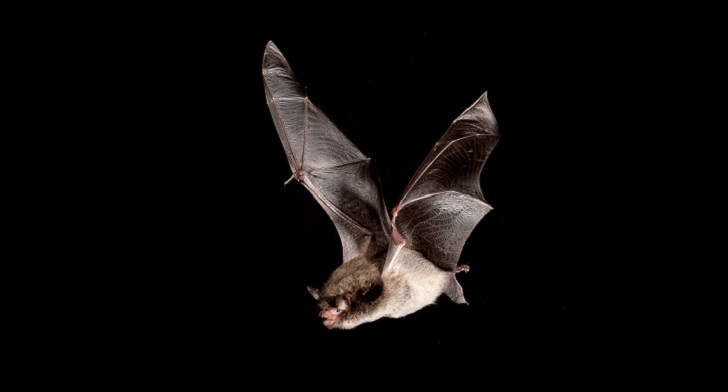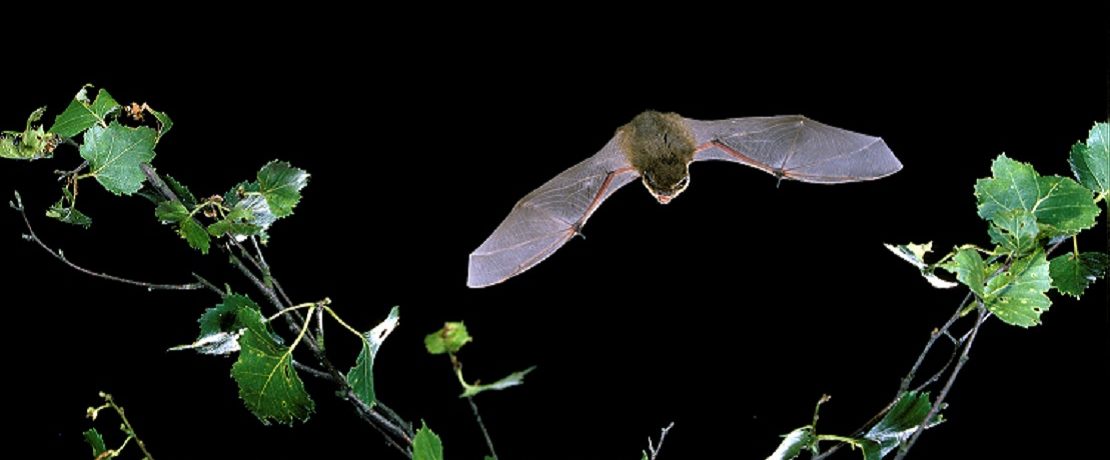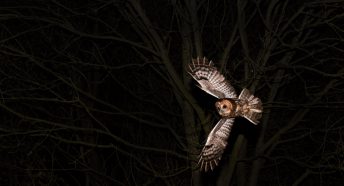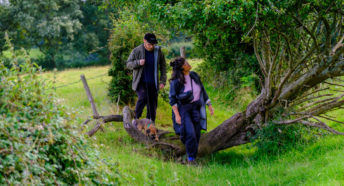Was that a bat?
If you’re out after dark now and into the summer months, especially in a green area, you might well be asking if that flicker in the corner of your eye was a bat or a bird. Shirley Thompson gives some hints.
Bat watching is a magical experience. The amazing aerobatics of pipistrelles at dusk as they dive and twist chasing their insect prey is something once seen, is never forgotten.
Unfortunately, bats are notoriously unpredictable, not always doing what is expected of them. But there are ways to give yourself the best chance of seeing bats.
Your starting point for both time and place is that all our 17 UK bats eat insects – they will be where the insects are.
When?
The most active time for bats is between mid-May and mid-October; they are hibernating or at a low level of activity through the colder months. Their young are born around June, so July and August are the months when numbers are greatest, with the young starting to fly.
Bats emerge in relation to sunset, but the actual timing varies depending on the species. And, of course, it means that those who live in the north must stay up later than bat-watchers in the south!

Weather conditions affect insects, and bat numbers will vary according to wind, cloud, rain and, of course, temperature. There is not a great deal of insect activity below 8°C, and the warmer the better. Cloudy nights tend to be more productive than very clear ones; insects – and bats and people – usually avoid strong wind and heavy rain. So the best bat-watching nights tend to be warm, still, cloudy, and dry.
Which bat is which?
Different bat species prefer eating different insects, catch them in different places, display distinct flight patterns and hunting strategies and vary in their geographical distribution. So, how to recognise which bat is which?
First of all, make sure it is a bat and not a bird that you’re watching! Most birds are coming home at dusk, when bats are just heading out, but there is a period when both are flying. Birds generally fly more smoothly, whereas bats fly more erratically when chasing insects.
The bats you are most likely to see are pipistrelles (see main image), particularly around your garden or local park. They have adapted to living in urban habitats as well as their more natural woodland. They emerge at dusk in time for us to see them flying and feeding in our parks, gardens and along waterways.
Like all bats, they look much bigger than they really are; their large wings give the impression that pipistrelles are the size of a sparrow, whereas in fact, with wings folded one would fit into a matchbox.
Both common and soprano pipistrelles look very similar, twisting and turning around buildings, streetlights, trees and hedges. They are the bats most likely to use a building temporarily in summer, as the mothers need somewhere warm to raise their young. For a few weeks they may live behind the barge boards, in the soffit, behind weatherboarding or hanging tiles.
Track a bat
If you are fortunate enough to know of a bat roost, you can enjoy watching as the bats emerge and perhaps count them regularly as part of the National Bat Monitoring Programme (NBMP). If you can cope with early mornings, you might even watch them return at dawn – it can be spectacular – but you need to be there before it starts to get light.
Even if you don’t know where your local roost is, you can still help monitor bats. NBMP has a variety of surveys suitable for all levels of experience, from beginners to experts. The sunset survey is for everyone and can be done from your garden, balcony or local green space. Find out how to join in here.
The noctule, one of our biggest bats, emerges before sunset while it is still light and mainly flies in a straight line. Its long narrow wings can be recognised even when it flies very high, making steep dives when chasing insects.
Long-eared bats come out after dark, making them difficult to spot. Their flight is slow and hovering, a little bit like a big butterfly. Broad wings make these bats very maneuverable but slower in flight and more vulnerable to predation, so they emerge later and keep close to, or even within, the branches of the trees as they fly.

Emerging even later, the Daubenton’s bat is one you have a good chance of seeing as long as you have the patience to wait until well after dark. They fly very low over lakes and rivers, skimming the surface like a mini hovercraft. Watch carefully and you may see them touch the water with their big feet to take an insect.
In the south of England you might see serotine bats. Although as large as noctules, they have broad wings and fly lower with a slow, flapping bird-like flight reminiscent of a blackbird.
Where?
Trees and other plants are vital to bats, as so many types of insect feed on them. Water is also very important for the insects it supports, many, such as gnats and midges, spending most of their life cycle in water. So, water with vegetation close by is the best place to watch for bats. Ponds, rivers, lakes, and canals are always good places to look, especially if they are linked into a network of hedges and tree lines.

Listening to bats
You can enjoy just watching bats if you are sharp-eyed and patient, but to add a whole new dimension to bat watching you really need to listen to them, too. My first experience of doing so, nearly 40 years ago, is still clear in my mind. After one of the earliest meetings of our bat group we went into a local park for a demonstration of a new-fangled device called a bat detector, something familiar only to the handful of people studying bats at that time.
Incredibly, though seeing only the occasional dark shape fly past us over the lake, we were able to hear pipistrelles, noctules and Daubenton’s as they foraged and fed. I was hooked! Even today, when there is a much greater awareness of bats and their system of echolocation and a whole range of detectors is available, I still enjoy the look of wonder on the face of anyone hearing those sounds for the first time.
How can I support bats?
Invite bats to your garden or close to your home, by growing flowers that attract plenty of insects, the food on which they depend. Bats need huge numbers of insects from spring to autumn. If you can make your garden or window box a place that insects regularly visit by planting a range of flowers, varying not only in colour and fragrance but also in shape and season, that will encourage different insects to drop in and refuel.

The importance of this sort of planting to our declining populations of insects and birds is constantly highlighted in magazine articles and television programmes – an important step in slowing the alarming rate at which some outside areas have been rendered lifeless beneath paving and timber. In 2008, the Department for Environment, Food and Rural Affairs (Defra) included bats in their set of ‘indicator species’ which help measure progress towards the target of halting biodiversity loss. Even carefully planned planting in a containers or window box can be valuable to hungry bats.
Shirley Thompson has been involved in bat conservation since 1983 and is the Honorary Education Officer at the Bat Conservation Trust, the Editor of The Young Batworker magazine and an active member of the Kent Bat Group.









